New Horror: An Evolving Genre
When a large scale photographic print is placed before a viewer, they immediately begin with the elaborate decoding process that the image evokes. If there are figures positioned in a knowable environment, the scene takes on the configuration of a cinematic still through which stories begin to unfold. Past, present and future trajectories are inferred to enable a coherent and telling narrative for why these figures have found themselves here, captured in this moment. The evolving genre of what I will call in this piece ‘New Horror’ often expresses the density of its narrative thread in a singular intense image. For the essential human feelings of terror, anxiety and unrest often come in the form of a single arresting moment, a horrifying image. More on this below, but first a brief scenario…
Perhaps we find a young woman, vulnerable and slight, sitting on the edge of a large couch and next to her a nude, androgynous, paramour sprawls out with his back towards us. It is a scene set in a rural-suburban location, where trees line the space outside the windows of a small, cluttered living room. A seemingly familiar scene, teenage angst and ambiguity arising in the process of afternoon experimentations with sexual desire and frustration. The young woman seems visibly lost and uncertain about the choices she may have made or actions she was coerced into.
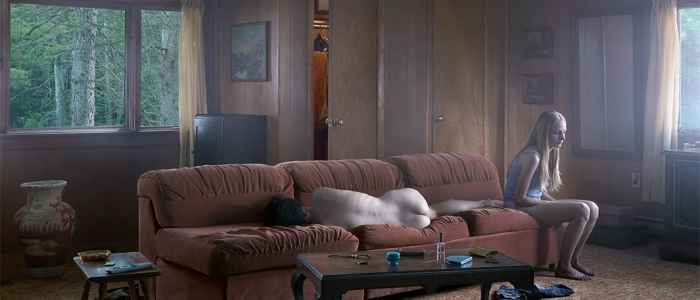
Yet something suddenly strikes the voyeur/ viewer as they peer into this intimate scene, undetected and reveling in the melodrama of the captured moment. The whole scene is bizarre in its atmospheric intensity, niches of dark space behind the couch and from the open closet door disturb any simple viewing; an ominous air hangs over the room. This is a photographic work by artist Gregory Crewdson and its title, simple but symbolically complex, The Den (2013). Beginning with Crewdson is an interesting and productive way to discuss the ‘New Horror’. It is through his work and its complex connection between the fine art realm and the popular horror and psychological thriller film-culture-realm that a new and evolving phenomenon in horror cinema can be discussed.
This is an recent and yet exciting development that works its way through two films that illustrate possible directions for a return to a Horror genre with depth and intellectual intensity. This is significant for two reasons: one being that the current state of the horror genre is one of bloated market based banality, one slasher after the other with no solid plot lines or attempt to reach another level of complexity. A second reason being that the Horror genre has great potential to deal in the darkest regions of the human psyche and connect back to social and political realities, past or present. Two films, diverse in approach and content that share a few key characteristic traits of a new and evolving horror genre are It Follows (2014) and Pontypool (2008). These films are only new in that they are old, only progressing because of a reverence for the past and a will towards innovation that builds on so much amazing precedent in the psychological thriller and horror genres.
The two films in question reinvest in the psychological sublimity of the social structure as a bizarre and humanly crafted thing, horrifying in its possible meaningless absurdity. In a word, there is a deep investment through all these films in the ‘unheimlich’ or what in the English language translates to the ‘uncanny.’ This will be the singular term that speaks and is spoken across the two films. The uncanny as 19th century psychologist and father of psychoanalysis Sigmund Freud meant it, translates more towards the ‘un-homely’, to make the familiar and ‘homely’ suddenly strange and simultaneously unfamiliar. The uncanny has a long tradition in the fine arts and in cinema. The uncanny as a concept has great weight and meaning in many of the iconic works of Hitchcock and more recently and significantly David Lynch. These films, from Hitchcock’s Psycho to Lynch’s Eraserhead or Inland Empire are of a type and yet defy the limits of any genre. This unfettered play between genre and type is also characteristic of the new horror.
In fact, there are many connections between Lynch’s psychological brand of thriller film and Crewdson’s artistic form and content. Crewdson’s influence comes in most directly as a fine artist and conceptual photographer through the content of the uncanny and very specifically in the technical creation of psychological atmosphere. It Follows, a film deeply influenced by Crewdson’s work, is the launching point for understanding what is new in the ‘new horror,’ aspects that are innovations derived from accumulated influence and perhaps new problems. For the writer-director and mastermind behind the film, David Robert Mitchell, and his cinematographer Mike Gioulakis take largely from and openly discuss the influence of Crewdson’s work on the cinematic style of It Follows.
Crewdson and the Evolving Genre
Returning to The Den, it’s possible to elaborate on the interconnections between the photographer and the cinematographer. The image is alienating and bizarre in the raw intensity and imbalance between the young women’s vulnerability and the cold impenetrable nakedness of the young persons back sinking down, taken in by the plush sofa. Uncanny and jarring the entire scene takes on a new appeal, sweeping in to unnerve the voyeur/ viewer. Techniques rendered here in the photographic space are transferred in vivid detail to the cinematic stage sets of Mitchell’s feature film. The dense psychological atmosphere is created through lighting, digital manipulation and an acute focus on detail that leaves no part of the scene untouched or unseen by the director, a perfect construct.
Lighting is key to the projection of a tangible psychological atmosphere, and the distortion of the mundane scenes from suburbia that Mitchell deploys to stunning effect in It Follows. Adding depth and form to our experience, light comes in to transform the moment: traumatic and blaring, soft and sensual, sweeping, dizzying and sublime; light transforms and transmutes. Mitchell and Crewdson before him, utilize these atmospheric effects of dramatic stage lighting, Crewdson’s photographic work has become a sort of laboratory for the experimentation of lighting effect as emotional affect.
More to the point here, Crewdson is decidedly a “conceptual photographer,” which is to say that the finished product is also wrapped up in a network of meaning, where process and concept are as important as the image produced. As the artist states in a 2002 interview with Chris Chang of Film Comment, waxing on “with theoretical intuitiveness: ‘I’m using light to create a narrative code. Specific strategies are telling specific stories. I’m particularly interested in expressing psychological or interior ideas with light.” 1
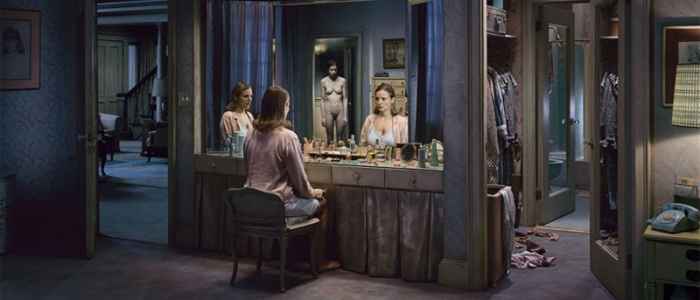
Crewdson, as Mitchell, is interested in light and in the Freudian uncanny; he is interested in expressing the outward extension of an inner reflection. At once, in all of this is the complexity of the social realm and its political consequences, this is what influences Mitchell and his cinematographer Mike Gioulakis. The two unwind an elaborate narrative of real complexity dealing with issues of sexuality and difference. It is here that both Crewdson and Mitchell meet, it is in the levels of drama they infuse into the image whether throughout a feature film or in a single, epic photographic-still. As Chris R. Morgan states in his review of a recent exhibition “Cathedral of the Pines,” for the American Conservative, “A typical Crewdson shoot is not far removed from the collaborative chaos of film production, involving full crews, special effects and performers, all in the service of telling a story within a single frame.” 2
Thus, the influential impact of Crewdson’s work on the newest cutting edge of psychological horror dramas such as It Follows, is wrapped up in the cutting edge of fine art conceptual photography. Taking the mundane and quotidian rural-suburban-scenery and figures of white America, Crewdson has incited a transformation of these scenes. He has re-awakened a penchant for the uncanny and sublime, creating photographs that read more like cinematic stills and envisioning scenes that become akin to the density and complexity of dream condensation, creating enigmatic visual riddles.

Throughout the photographic series that really launched Crewdson’s personal exploration of the rural suburbs as uncanny space/ place, Twilight, there are images of psychic breaks that defy convention. It is at once a psychological state made exterior, pushed out into the world to warp and displace its seeming normality. For Crewdson it is also a deep belief in the utter strangeness and otherness of the suburb community, isolated in its own unique way from the density of the urban metropole from which it derives its wealth and sustenance. Crewdson has made an open avowal that he is “fundamentally interested in the uncanny, which is almost by definition like trying to find an unexpected mystery in everyday life.” 3 So too Mitchell seeks to unravel the hidden anxiety and lurking realm of the bizarre hidden under the pristine veneer of the American suburban ideal, complications of sexuality, existential worth, squabbles for power, all lie repressed ‘beneath the roses’.
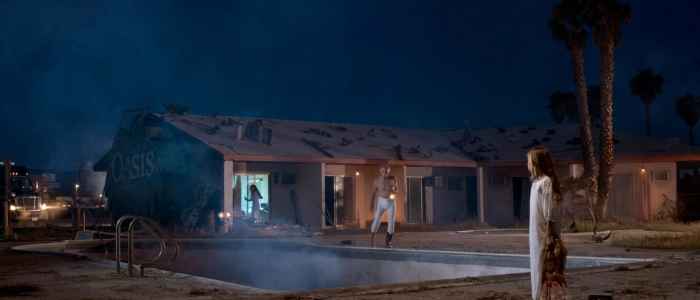
Social Content and Horror’s Uncanny Potential
Theorists, philosophers and aestheticians, from Peter Shklovsky in the early part of the 20th century, speaking on Russian constructivism and photo-montage, to scholar Theodore Adorno with his tome on aesthetic theory, have spilt much ink on the concept of art as that which breaks us away from the ordinary, from the stupifying regularity of the mundane. Shklovsky writes on arts ability to shake us from the stupor of our quotidian constancy: the numb and desensitized vessels that we become through daily ritual are in need of a shock, a radical perspectival shift, to become aware once more of our surroundings. 4 Art, the cultural objects and products imbued with the whirlwind of lived social and political realities has the ability to do just that by taking daily experience and shaping it anew.
Adorno writes on arts purposive nature, it’s truly subversive potential in providing, “a reflective space for the critical cognition of reality”: apart from socio-political constraints and everyday experience, the weight and significance of the moment returns. 5 Horror has the potential to play this truly subversive role, it has the potential to turn a critical lens onto social and political realities, shocking us from complacency. It Follows, for example, haunts the privileged space of middle-class rural and suburban white America, a space wracked with the sudden moment of return and transfiguration, when that which is and has been repressed begins to warp the solidity and coherence of the dominant narrative. This is the social content that becomes woven into the dense fabric of the genre.
Within each film under examination, there are the central strands of social issue and impact circulating through the plot. Pontypool takes up a decidedly complex issue, language, and turns it to narrative fodder, making accessible the theoretical point of language as encoded or representative of an ideological construction. Language is literally infected in the film. This concept of an infection taps into the central way in which language shapes and inflects our understanding of reality. It is only once language is revealed as the culprit or vessel for infection that the viewer becomes alive to its ubiquitous hold over the individual and their potential expression in society.
In the 2014 film The Babadook, similarly, there is a central issue which allows for social critique and reflection. This film can also play a role in understanding the dynamics of the new horror. In the film, a single-working mother, worn thin with the ravages of economic instability, loneliness and insecurity, faces the looming specter of a child beyond her control. She then faces the reciprocal social stigma of being labelled neglectful or abusive. The uncanny figure of the Babadook comes in as the accumulated mass of these really existing social specters, in a way he is a beast of social stigma and the resultant psychic trauma.
Language also plays a significant role in The Babadook: “if it is in a word or in a look, you can’t get rid of the Babadook.” With this disturbing quote we can understand the way in which the Babadook, as an entity, pervades the dual expressive modes of the utterance and the gesture. The social stigma of the neglectful or abusive single-mother also plays out in numerous metaphorical terrors: a favorite of mine, with serious potency is the cascade of roaches that invade the house crawling the walls, pointing simultaneously to domestic neglect/ filth and the skin crawling horror of infestation. Social stigma is taken up in such under-rated films as Woman in Black one and two: in the second film, there is the continued period piece setting that revolves around the children spirited away during the London bombings of WWII. There are several scenarios of social stigma embedded in the film, such as character Harry Burnstow’s revealed desertion from the British forces due to the traumas of warfare.
One last film that must be briefly taken in account before preceding to the two films under analysis is the very recent Get Out (2017). I would place this amazing production from the mind of writer/ actor/ comedian Jordan Peele into the categorization of the evolving Horror genre. Provocatively, the film takes the complex American history of entrenched racism and manifests it as a central plotline in the horror-show that unfolds. Taking up heavy issues of inter-racial relationships and the degeneracy of the moneyed-elite, the movie makes the nations white aristocracy bizarre, uncanny and ultimately ghoulish. Pontypool will be discussed further below but first a continuation of It Follows, in which the central issue shifts and unravels with evolving complexity.
Either creature or entity, that which follows, is passed on from person to person by sexual transmission, yet it is really the traumatic reality of a being constantly following that cannot be seen or even spoken of in a coherent manner. Once again, it is the trace of the social that pervades, it is the disrupted ideal of the rural suburb, which is posed against the ruins of the urban periphery that the teens must enter to confront ‘it’. Like Crewdson’s fascination and exploration of the suburban realm as uncanny, a notion he had from a young age as a city kid in Brooklyn, Mitchell draws on a personal notion of psychological anxiety for his thematic. Derived from a childhood memory of dread at the thought of some non-descript person following him, writer-director Mitchell turned this haunting notion into a feature film!
It Follows
Opening with a classic sequence of the suburban cul-de-sac, the viewer instantly connects with the uncanny dread of an unseen entity that pursues the young woman about to meet her gruesome death. As she reaches the water’s edge, which we must assume is either Lake Huron or Erie, being that the film is set in a Michigan suburb, the mist drifts in and the night wraps around with only a narrow shaft of light provided by her car’s high beams. Her death is unseen as well as her assailant and all we are left with is the corpse in a gruesome position of violent corruption, splayed out on the lake shore. We are then quickly ushered into the lives of a small circle of friends, the usual dynamics apply, romantic entanglement and teenage ennui take center stage.
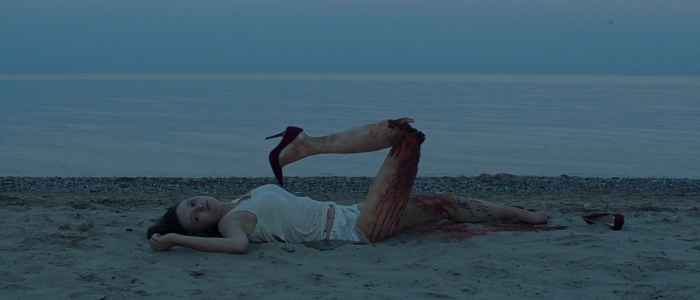
The wide-angle shots and lo-fi soundtrack disrupt the usual perspective on the suburb, it is shot through with a nostalgic aura but it is a scenario on the verge of chaos and tumult. In shots that seem to be culled directly from the dreamscape interiors and neighborhoods of Crewdson’s series of photographic exhibitions Twilight, Beneath the Roses and Cathedral of the Pines, we are faced with surreal and uncanny depictions of trauma. Main character Jay ‘contracts’ the entity from a young man, Hugh, who contracted it from another, she is drugged, bound to a chair and made to face the entity in the bombed-out, rubble remains of a Detroit factory. She is then deposited on her front lawn in nothing but bra and panties, so that the entity appears to be nothing but the delusion of a psychic break.
The plot ensues, the thing follows, but what is this entity? At face value, it is like few other creatures, monsters or entities dreamt up by the horror or psychological thriller genre, it is an amorphous, shape-shifting figure taking on the form of a host of characters. Here the uncanny sweeps in and engages with the bizarre and absurd nature of our social narratives, for each figure is only as terrifying as our normative ideas on the body are limiting and ideal. Each figure is a body stripped down to undergarments or obscenely naked; each figure becomes a hostile mound of flesh detached from its human element, in its singular fixed drive to pursue, to follow.
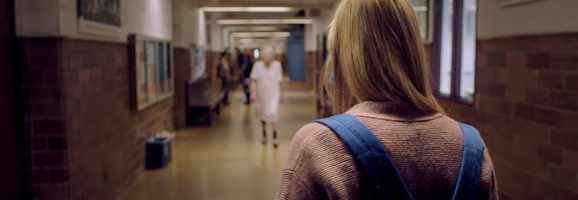
To so many feminist and post-modern scholars, particularly French scholar Julia Kristeva, the notion of the body made grotesque or of the ‘abject’ body, is a controversial and subversive representation. The abject is all that which resists the perfect ideal of sweet smelling and youthful flesh, it is the reality of our finite and mortal self, venerable to wear and abuse, to decrepitude and death. An elderly woman, ragged and disheveled in a nightgown gropes towards Jay on her high school campus, and it is singularly terrifying because this is the form ‘it’ has taken, an obscene figure not meant to be paired with the youthful faces of the campus. This socio-spatial disjunction is also present in the scene described above with Jay’s first encounter with the thing in the bombed out, deteriorating Detroit factory, youth and beauty, teenage sexuality posed against industrial decay.
A symbolic and physical negotiation with sexuality is key throughout the film: a perverse or traumatizing manipulation of the sexual, sex and sexuality become points of dread, weapons and tactics. From the eerie scene of Jay’s sexual encounter with Hugh, in the lot of the abandoned factory, to the kitchen confrontation with a battered and naked vision of the entity, there is the systematic transformation of the mundane into the site of horror. The uncanny twist takes a familiar suburb and a familiar encounter with failed or embattled adolescent sexuality and makes it an epic struggle for life and liberty, this also transforms the entire film into a symbolic nexus. And the cinematography continues throughout to aid the plot in its epic of horror and transformation.
In one encounter with the entity, it simply looms on the roof of Jay’s house as her and the crew drive off. It’s nude male form pierces the viewer with his gaze as the darkened sky hangs overhead and the entire cul-de-sac becomes frightful. As critical theorist Theodor Adorno once stated in his Minima Moralia: “Horror is beyond the reach of psychology.” Is this residue of a trauma so unspeakable and so violently corrosive to the psyche, repressed and driven beneath the framework of language, our moment of transformation, our horror?
To drive deeper at the core of the film and its symbolic heft, one must examine the hidden but present dichotomy between suburb and city. The film takes place in a suburb of Detroit, this becomes clear in the multiple conversations the cast has about 8-Mile and their precarious position on its northern most border. Always told to beware of the southern part, Jay also refers to her would be boyfriend and assailant as living in a rougher neighborhood that represents a state of crime and poverty he didn’t want her to see. Detroit and its suburban tributaries present the perfect stage set for a suburban-smalltown mythic resisting the criminality and poverty of the urban inner-city.
This is a mythic that then haunts the film and its characters with its blatant repulsion and discrimination of the diverse urban core against a homogenous-white-suburban middle class. We can see this as part of a new horror genre that indirectly or directly figures in the socio-political issues of suburban sprawl and gentrification, pointing to the bizarre and absurd representations of the inner-city as always supremely other. It is interesting that the final showdown with the entity takes place at a public pool just south of 8-Mile, towards the site of urban dissolution that is Detroit. Here we can introduce the socio-historical understanding of the Smalltown-suburban USA mythic as a nostalgic lie, its creation and perpetuation as a way to preserve a never-existing unified whole, a home that never was.
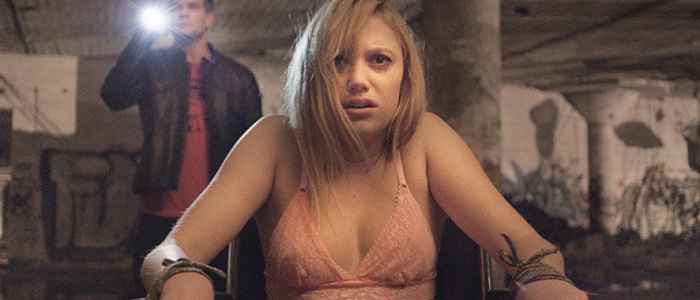
Referring to historian Christopher Lasch, we can understand the myth of Smalltown U.S.A as one of three major nostalgic episodes through which American popular consciousness passes, as it pushes from colonization to modernity. Lasch lays this out in a concise formulation: “once America had practically exterminated the natives, it idolized the Red Man; once it had traded pastoralism for industrialism, it worshipped the Marlboro Man; and once its growing towns and cities had become impersonal and oppressive, it created the myth of Smalltown, USA.” 6 Thus, each nostalgic episode obscures a then repressed past of violence and instability, this past existing and colluding with the repressed present of urban difference makes for the uncanny ripple on filmic and photographic surface, as psychic discontent manifests.
Pontypool
The opening scene of the low-budget indie thriller confesses openly to its theoretical borrowings from such cultural critics as Roland Barthes, overall, steeped in the post-modern debate on language and reality. The main character, Grant Mazzy, drives into a snow storm as he listens to his own rhetorical flourish on morning radio filler: a spot where he contemplates the strange linguistic and semantic plays behind the recent headlines in Pontypool, involving the meaning of the word Pontypool itself. Altogether the viewer is made decidedly aware that things are not what they seem, both what they seem to be visually and verbally.
There is a strange distortion here in the filmic space and it exists within the subtle interactions between the three main characters and the overall construct of the small Canadian town in the midst of apocalyptic chaos. Small budget works wonderfully for this script as the major plot points evolve on the faces of the characters reacting to and experiencing them in a purely audial way from within the radio-studio-cum-bunker. We have an alcoholic burn-out radio personality on his last lap, Laurel-Ann, a young female Iraqi-war veteran doing the production and Sydney Briar, an anal divorcee production manager, who’s hell bent on suppressing Mazzy’s more outrageous on-air statements.
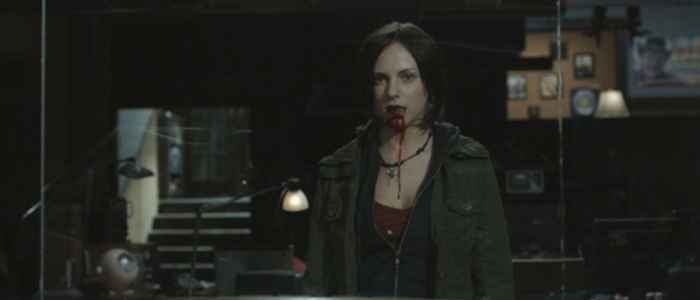
Gradually, revelations of a major town-wide disturbance come to light as there is major civil unrest, essentially a violent riot around a local doctor’s office. Provocations all center around a verbal core: zombies chanting, incessant repetition of seemingly inane phrases, “the language itself has become infected.” This infectious repetition of phrases is hinted at early on in the film through various characters, most startling is the sudden and incontrollable repetition of a simple sentence from one of the actors in a troupe doing a spotlight for a local community theater performance of Lawrence of Arabia.
The breakdown is gradual and then a rapid explosion of action. The Iraqi war veteran is the first in the studio to become infected and with her it is a flurry of repetition that she can’t make sense of and neither can her production manager. A moment of trauma, the confusion and dismay at local reports of the chaos unfolding in the small town, seems to be the cause of Laurel-Ann’s lapse into stuttering dysphoria but she soon becomes violent and aggressive. The dueling realities of an Iraqi war veteran dealing in the trauma sustained from her experience abroad and the artifice of the zombie-plot-line hold in suspension the impact of this scene.
Throughout the film, the uncanny light that persists in It follows can also be seen to frame certain scenes in order to play up their uncanny reality and warp the viewers relation to them. The initial blizzard that Mazzy first drives through obscures the camera focus and the whole flurry of precipitation is back lit to show eerie patches of light floating through the storm as Mazzy is confronted with the woman at his window. It is also in the radio station that the most dramatic scene appears, one that could easily parallel anything in Crewdson’s oeuvre. When Sydney, Mazzy and the good doctor look out to see Laurel-Ann bleeding from the mouth in full zombie trance, the light is refracted and the angle is blurred by the blood smeared opacity of the plastic sound booth, the figure of Laurel-Ann is transformed and grotesque. Beyond this, the shots of the shuffling hordes through the glow of snowy atmosphere make these wintry scenes compelling and horrifying.
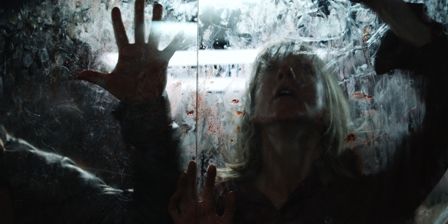
It is the bizarre twist on all the normal dysfunctions of the small town that also give the film a heightened sense of the uncanny. At the outset, a strange incident between ice fisherman and the local police department is called out by Mazzy: he blasts the small-town incident, chalking it up to drunken conduct on both the citizen and police side, usual small-town dysfunction. However, these incidents are just so many symptoms along the way to total pandemic outbreak and zombie hordes. The unnerving communications with ‘Ken in the sunshine helicopter’, narrating the unrest, escaping death several times only to succumb to the disease, delivers another kind of impact. It is his phantom voice streaming into the station that causes Mazzy to question his very sanity and fall into a momentary state of paranoia, questioning the other characters.
To read further into the metaphoric structure of the film, it is the very breakdown of an incommunicative horde, language broken and meaning lost that causes chaos. There is an overarching thematic of a society puppeted by authoritarian control, collectively chasing after the next phrase pumped from the loudspeaker of the radio-station. The ultimate scene of resolution, a possible antidote to this infection of language, comes only after the doctor flees the radio station, himself infected and impotently surrendered to his fate. Once again, all the normal possibilities are there, a doctor with an antidote, yet, something fails, the familiar is turned hauntingly against itself, turned uncanny. It is instead Mazzy and Sydney who are left to save the world.
The two remaining main characters find that if they confuse the meaning of individual words themselves, distorting the reality that they suggest, and replacing them with arbitrary meanings, they can break the zombie state. In a scene that is self-consciously trite with romantic sentiment, Mazzy grabs Sydney as she spirals off in the symptomatic stuttering that signals the infections spread. He tries to confuse her understanding of the word, signaling that it takes more than a single rogue agent to restore order. The word that issues from her quivering form over and over is KILL, KKKKILL, KILL. Mazzy desperately searches for alternatives and settles on one with some emotional heft, he shouts it out: “kill isn’t kill, kill is kiss, kill is kiss.” And then to reaffirm this new meaning for the infected word he gives the gratuitous smooch. Unfortunately, at this point, the state has moved in and quarantined the area, resolving to level the infected town by aerial bombardment.
Works Cited
What do you think? Leave a comment.











Pontypool could easily be a stage play, and it should.
I absolutely agree, it would translate well to the stage or even as a radio program in the tradition of Orson Welles.
I have never seen a horror movie done webcam style before!
One of the few things that utterly terrified me about this movie is how it began with a single killer, then transitioned to show another with him. It felt very natural and creepy. However I was caught off guard when they begin showing that its not just 2 but 10+ people possibly even more into the hundreds who were doing this internet stalking and murdering. I did not expect this at all but it was completely believable and very smart in my opinion.
The movie is your typical shaky cam crap.
I must be one of the few people who were disappointed by the babadook although how much of that was due to the quality of the film or my exceedingly high expectations because of the massive amount of hype that went along with it I’m not sure.
The Babadook was the most overrated film of its year. It was absolutely terrible. A low-budget melodrama about an increasingly hysterical mother projecting her grief onto her child, it integrated the paranormal aspects very badly and was tonally all over the place. It was soap-opera nonsense loosely stapled to an underdeveloped ghost story.
I felt the same way about The Conjuring
New Horror looks like a genre I could get into! Thanks for the intro.
wow I have never really liked horror, however I might take another look
You definitely should, the films discussed here bridge the gap between traditional horror and psychological thriller. They are much more dynamic and dramatic than the straightforward gory slasher, although those can be good too!
I’m a HUGE horror fan so this is really interesting to me!
Awesome, I wrote this with horror junkies in mind and hope for some it gives new depth to their passion for the genre.
Love it! Really interesting piece 🙂
I only found out about Pontypool last night when I read your article. I downloaded it overnight & had to watch it when alone, my boyfriend won’t even watch The Walking Dead. Best movie I’ve watched this month. Thank you so much!
Wonderful! that’s all I can hope for, to turn someone on to these innovative films.
When it comes to atmosphere and creepiness, “It Follows” does such a good job.
I agree. But sadly that’s all where it excels at
The indie scene is where horror lives today. Forgot the twentieth Halloween reboot or the January dump truck that unloads all the mid-budget horror flicks that the studio wants to die quietly.
Definitely, that’s what the “New Horror” is really, the emergence of well written and acted independent films changing the genre. Those reboots are a crime against horror, haha.
This. The past few years have given us Oculus, The Witch, Don’t Breathe, and admittedly the return of M. Night Shyamalan to elevated B-movie form.
Very true. Micro-budgets and filmmakers eager to subvert the genre are giving us some of the most well-crafted scares that we’ve had since a creative dearth gave us seven Saw movies.
A good rename to It Follows would be “STG: Sexually Transmitted Ghost.”
Haha I’ve always referred to it as a sexually transmitted demon or STD
Excellent, and comprehensive, overview of the horror genre throughout this century.
Pontypool is one of the most thrilling films I have ever seen. A horror film that has no need for CGI and explicit scenes of violence to make it work.
Exactly! I completely agree, its all about timing, dramatic acting and the pace of the narrative, such a great film.
Get drunk and watch It Follows and you’ll freak yourself out so bad. This movie really messes with your mind when you’re drunk.
Great article, well put together.
‘It Follows’ and ‘Get Out’ have definitely been a turning point for me in a genre I’ve generally disliked for as long as I can remember. Reading this excellent article has really made me want to check out Pontypool.
great comment on The Babadook re subverting normalness – imaginative reality always has more effect on the audience than unimaginative realism.
The psychology of horror, something you’d expect but a twist like Oculus and The Visit. I quite enjoyed those films, though my friends would think otherwise. Haha.
I loved both those films as well.
Pontypool was on a “to watch list” for awhile and I never got around to it.
I’m really not a horror movie person, and I have a particular dislike for Torture Pron. I just don’t get why people want to watch that.
Torture does nothing for me either. Any film maker thinking of making a horror movie should watch The Texas Chain Saw Massacre or The Exorcist to learn how it should be done.
It’s interesting how the genre is dictated to by current society and cultural trends, perhaps like no other. It’ll be interesting what appears next…
…perhaps something to do with social networking perhaps.
Great article! As a horror junky, I’m glad to see this evolution in the genre. Of the films mentioned here, I really liked both It Follows and The Babadook. Still need to see Pontypool and Get Out, but they’re both high on the list!
It’s quite striking how good the films are referenced here!
The evolution of horror movies is quite interesting in the way writers need to keep updating their ideas in order to fit the changing and developing world. After all, the scare factor of a movie becomes much bigger when the situation is relatable and feels like something that could actually happen to the viewer in real life.
That is scary!
Reading this I’m reminded of American Horror Story. Some people can’t understand it’s title as “Horror” but I try to explain it has both supernatural and everyday horrors. Sometimes real life horrors are far more effective than a bloody slasher.
I agree, and actually considered referencing American Horror Story in this essay. The series is groundbreaking in its focus on uniquely American occult myth and legend, beside the outstanding cinematography and cast. Definitely an important part of the evolving genre.
Great article and a fantastic incite to “new horror”. I’m a huge horror fan but have neglected how light can create such a scene, and I loved the way you have described this!
Get Out is an amazing film, and a horror movie which I believe everyone should watch due to its social commentaries.
Thanks for the article!
I avoid horror films no matter who directs them.
I love the complexity and the changing nature of the horror genre. This was a fantastic and insightful piece into the horror genre.
I’m yet to see Pontypool, but it’s made its way to the top of my watch list now!
Is the new horror flashing back to the past?
Niceee 👍🏽
Horror can be seen on the daily News or a TV Documentary. The challenge i perceive is for a film maker to actually be able to create a horror movies that does scare and shock us. Sadly we are a society numbed to special effects and predictable story lines. A great horror needs to be a psychological thriller, the ability to play with your mind and portray the ‘dark’ side of the human race. The horror you feel is deep within us, and the degree of our empathy and acceptance of narcissist and psychopaths.
I feel the opposite actually. I think striking images are losing their power in horror cinema. Not to say they aren’t useful, cinema is a visual medium, however, the ability to scare with an image seems less and less prevalent, and if there is anything that “New Horror” has the old horror didn’t (or at least recent history horror) is good acting. It is no longer the place for Disney kids and pop singers to cut their teeth before taking bigger and more mature roles, and the young people who take on these movies now are not quite as amateur as they once were. I think newer horror is remembering that the quickest way to strike at the heart of your audience is to create an empathetic relationship with your characters. This way the actors sell the reality of the situation, instead of the tableau. IN all other genres, we laugh when characters laugh, we cry when they are sad, and we are worried when they don’t see a way out. We will be scared when they are scared. What makes Pontypool, for instance, so great, is it essentially takes the found footage genre (generally speaking) one meta level further. Instead of listening to the broadcast (in this context; could be substituted with other recording), we are now watching people listening to the broadcast. McHattie and Houle sell us on the fear when they are visibly disturbed by what is being reported. And that goes for a lot of the most recent great horror films: Babadook, It Follows, The Invitation, The Orphanage, Get Out, etc. I think its less about the tableau and more about the people in the narrative reacting to them, which is a process that evolves/unfolds over the entire runtime.
It is interesting to think about the new direction that horror films have been taking this decade, too critical acclaim, and yet when Universal tries to enter the game, owners of the biggest icons in horror, they opt for over blown action schlock. With The Mummy’s budget, you could have made 15 $10 million horror films, or even 150 $1 million films. It seems that they still believe that bigger is better, yet they seem to also be completely missing the “point” of their classic characters.
i just love horror movies and use to watch them when i am not alone at all..lol..
Very insightful piece! I never really understood the whole STD metaphor in It Follow. Your analysis makes a lot more sense to me. It’s certainly a movie with a multitude of interpretations, but I like the way you connect it to historical and spatial memory in America.
Thank you, yes I thought the std metaphor was too superficial. And the writer/director also agrees, when he was interviewed on the subject he definitely had more complex meaning in mind.
I watched Pontypool after reading this article and was extremely pleased with it. Very unique, intriguing and thought-provoking. The concept behind “infected” language and “double meanings” of words reminded me of Jaques Derrida’s concept of Deconstruction, especially in regards to his piece Plato’s Pharmacy.
Yes absolutely, I was going to go into that in the article but I thought Derridean theory might be a bit inaccessible to some. But I definitely had him in mind when I was writing this, he and Barthes were foremost in my mind. So glad I could turn you on to the film!
Good look into the world of horror, well done.